Jan 21st 2016
Framing with Acrylic Glazing - Some Tips
Framing pictures with acrylic glazing is problematic due to two properties inherent to acrylic sheet: Static buildup and scratches. This article teaches several things you can do to prevent static and also get rid of it. Scratches appearing on acrylic sheet come mostly from improper handling and attempts at cleaning. This article teaches tips and ideas on handling these problems.
Before you remove the paper or plastic protective sheet from your acrylic, it is a good idea to scrape off the burrs left by the saw. This can be done easily and quickly by scraping with the sharp edge of an open pair of scissors along all 8 edges at approximately 45°. If you do a lot of acrylic glazing, you should probably make an edge scraper, shown in the image at right, out of scrap steel or buy one like the one made by Craftics available from FrameTek, LLC
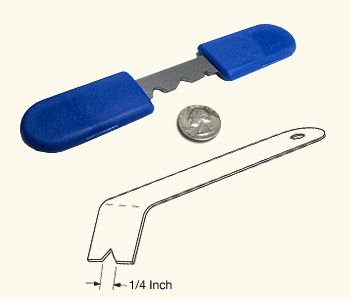 Above: You can make your own edge scraper from scrap sheet metal something like shown here or buy the commercial one available from FrameTek, LLC
Above: You can make your own edge scraper from scrap sheet metal something like shown here or buy the commercial one available from FrameTek, LLC
If you don’t get rid of the burr and later wipe your cleaning rag across it, the burr will break off and most likely scratch the surface. It may also break off when the acrylic sheet is put into the frame. Guess where the dust shows up.
Before you remove the protective covering, wipe down both sides and all around the edges with a damp cloth. This will kill the static and remove any dust particles.
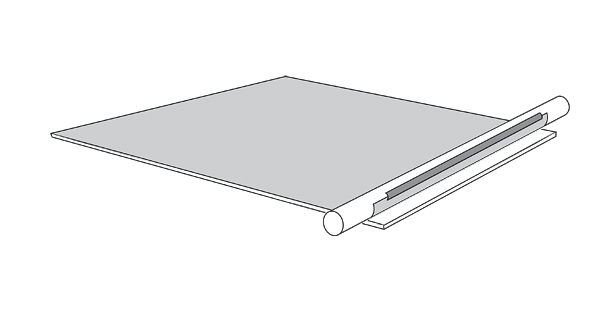 Above: Tape the first inch of the protective paper/film to a shipping tube or broomstick — peel slowly to prevent static.
Above: Tape the first inch of the protective paper/film to a shipping tube or broomstick — peel slowly to prevent static.
I recommend peeling up about an inch wide strip of the protective film/paper and tape it to a shipping tube, broomstick, or the like and roll the film/paper off SLOWLY. If you peel the covering off quickly, you will create static.
If you do a lot of acrylic framing you might consider making some sort of mechanism to make this job quick and easy.
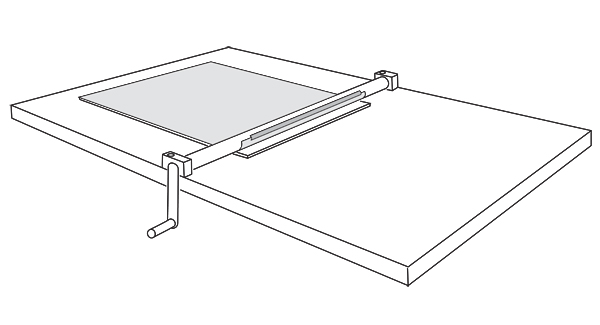 Above: My peeler looked something like this sketch above. I just dropped some long bolts through the end blocks into holes in my work table. Easily removable.
Above: My peeler looked something like this sketch above. I just dropped some long bolts through the end blocks into holes in my work table. Easily removable.
Clean both sides of your acrylic sheet with one of the anti-static cleaners. This will help keep the static in control. There are several on the market and here are a few: Brillianize, Novus, Sasigns, VuPlex, and I’m sure there are others. Get them from where you got the acrylic sheet.
When cleaning with these anti-static cleaners use a very soft cloth and don’t rub briskly or you will create static. Microfiber cloths work well for this job.
There are also anti-static guns and brushes available from Zerostat, Kinetronics and others. I’ve never used either but some folks swear by them.

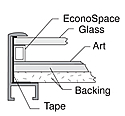
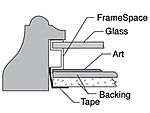

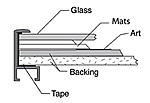

Above: Tape sealing keeps everything clean and only take a few moments.
Clean each layer of the art and backing package in turn from the backing up to the acrylic. Stack up your backing, the art and/or mats, then the acrylic all face up. When it’s all clean, “Tape seal” the whole package before you put it into the frame.
You can use regular Scotch tape as it is “acid free” acetate with a very stable acrylic adhesive.
Tape sealing has several benefits:
- No new dust, gold leaf flakes, wood scrapings, smoke, critters, or other pollutants will enter the frame job.
- Rapid changes in humidity (the great buckler of paper art) will be slowed dramatically.
- Any dust particles coming out of the edges of mat boards or foam boards will be trapped by the adhesive.
- Glass chipping in metal frames will be lessened and the chips will be held by the adhesive on the tape.
- It will save more time than it takes to tape seal if you don’t have to re-open just one frame a day.
See the article "Stopping the dust pump" for more information.
A note about “UV” acrylic: There are several manufacturers that have UV filtering acrylic. Most claim it filters out over 95% of the UV. This will help stop fading FROM UV ONLY. The rest of the light spectrum will still fade art work. This means any light, whether incandescent, fluorescent, sunlight, or reflected sunlight, will still fade your artwork.
Don’t hang ANY art work in bright light conditions - it will fade.
Anti-Static acrylic: There is acrylic available now that has anti static properties. I have not seen or touched a piece—I just know that it’s out there. The one I’ve heard about is made by Tru-Vue® and is called Optimum Museum Acrylic which is also anti-reflective.


